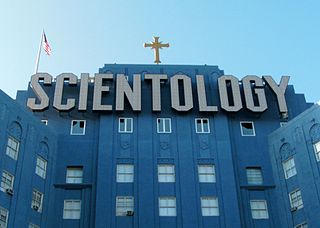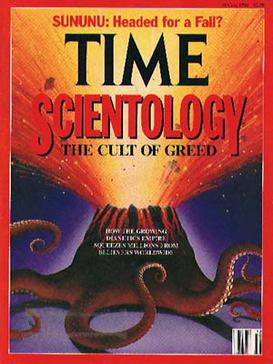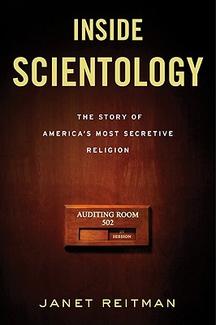
Xenu, also called Xemu, is a figure in the Church of Scientology's secret "Advanced Technology", a sacred and esoteric teaching. According to the "Technology", Xenu was the extraterrestrial ruler of a "Galactic Confederacy" who brought billions of his people to Earth in DC-8-like spacecraft 75 million years ago, stacked them around volcanoes, and killed them with hydrogen bombs. Official Scientology scriptures hold that the thetans of these aliens adhere to humans, causing spiritual harm.

Disconnection is the severance of all ties between a Scientologist and a friend, colleague, or family member deemed to be antagonistic towards Scientology. The practice of disconnection is a form of shunning. Among Scientologists, disconnection is viewed as an important method of removing obstacles to one's spiritual growth. In some circumstances, disconnection has ended marriages and separated children from their parents.

The Sea Organization is a core group of Church of Scientology staff members who have signed a billion-year pledge of service to Scientology. All Scientology management organizations are controlled exclusively by members of the Sea Org. David Miscavige, the de facto leader of Scientology, is the highest-ranking Sea Org officer, holding the rank of captain.

In Scientology, Operating Thetan (OT) is a state of complete spiritual freedom in which one is a "willing and knowing cause over life, thought, matter, energy, space and time". The Church of Scientology offers eight "levels" of OT, each level costing thousands of US dollars. The content and procedures of the OT levels are considered a confidential trade secret.

David Miscavige is the second and current leader of the Church of Scientology. His official title within the organization is Chairman of the Board of the Religious Technology Center (RTC), a corporation that controls the trademarks and copyrights of Dianetics and Scientology. He is also referred to within the Scientology organization as "DM", "C.O.B." or "Captain of the Sea Org".

"The Thriving Cult of Greed and Power" is an article, written in 1991 by U.S. investigative journalist Richard Behar, which is highly critical of Scientology.

Scientology founder L. Ron Hubbard explicitly compared his teachings to the science-fiction subgenre space opera. In his writings, wherein thetans were reincarnated periodically over quadrillions of years, retaining memories of prior lives, to which Hubbard attributed complex narratives about life throughout the universe. The most controversial of these myths is the story of Xenu, to whom Hubbard attributed responsibility for many of the world's problems.

Tory Christman is a prominent American critic of Scientology and former member of the organization. Originally brought up a Catholic, Christman turned to Scientology after being introduced to the book Dianetics: The Modern Science of Mental Health authored by Scientology founder L. Ron Hubbard while staying with her parents in Chicago. She identified with concepts described in the book including the idea of attaining the Scientology state of clear, and became a member of the organization in 1969. She hitchhiked from Chicago to Los Angeles, in order to begin the process of studying Scientology, and initially felt that it helped improve her life. In 1972, she joined the core group of staff members within Scientology called the Sea Org. After being a member of the Scientology organization for ten years, Christman reached the spiritual Operating Thetan level of OT III, and learned the story of Xenu. She subsequently rose to a higher Operating Thetan level of OT VII, the second-highest within the organization. Her medical condition of epilepsy caused difficulty while in Scientology, as the organization did not approve of taking medication in order to manage her condition.

Scientology ethics and justice are a collection of policies and procedures by L. Ron Hubbard and used by the Church of Scientology. Scientology defines ethics as "the actions an individual takes on himself", and justice as "the action taken on the individual by the group when he fails to take these actions himself". The body of writings include techniques and policies of moral choices, and the rules of conduct to be followed by scientologists.
When the individual fails to put in his own ethics, the group takes action against him and this is called justice.
The Commodore's Messenger Organization (CMO) is a management unit within the Sea Org, the unincorporated paramilitary wing of the Church of Scientology. CMO oversees the various other Church of Scientology organizations.

Michael John Rinder is an Australian-American former senior executive of the Church of Scientology International (CSI) and the Sea Organization based in the United States. From 1982 to 2007, Rinder served on the board of directors of CSI and also held the post of executive director of its Office of Special Affairs, overseeing the corporate, legal and public relations matters of Scientology at the international level.

This is a Timeline of Scientology, particularly its foundation and development by author L. Ron Hubbard as well as general publications, articles, books and other milestones.
The Church of Scientology publicly classifies itself as a religion, but scholars and other observers regard it as a business, because the organization operates more like a for-profit business than a religious institution. Some scholars of sociology working in religious studies consider it a new religious movement. Overall, as stated by Stephen A. Kent, Scientology can be seen as a "multi-faceted transnational corporation that has religion as only one of its many components. Other components include political aspirations, business ventures, cultural productions, pseudo-medical practices, pseudo-psychiatric claims, and, an alternative family structure."

The Bridge to Total Freedom, also known as the Classification, Gradation and Awareness Chart, is Scientology's primary action plan and road map to guide a person through the sequential steps to attain Scientology's concept of spiritual freedom. Displayed in every Scientology organization as an enormous poster using red ink, the comprehensive chart contains almost every service available within Scientology. All steps on the Bridge cost money.

Thomas William Davis is an American financial executive. From 2005 to 2011, Davis was head of external affairs and the chief spokesperson of the Church of Scientology International and Senior Vice President at the Church of Scientology Celebrity Centre International from the early 1990s. Between 2011 and 2013, Davis did not make any public appearances in the media. In June 2013, it was revealed that Davis and his wife had relocated from Gold Base in Riverside County, California, to Austin, Texas. He currently resides in Los Angeles.
Jenna Miscavige Hill is an American former Scientologist. After leaving the Church of Scientology in 2005, she has become an outspoken critic of the organization. She had been a third-generation Scientologist, the granddaughter of Ron Miscavige Sr., the daughter of Elizabeth "Bitty" Miscavige and Ron Miscavige Jr. and the niece of current Scientology leader David Miscavige. Her book Beyond Belief: My Secret Life Inside Scientology and My Harrowing Escape, recounting her experience growing up and living within the Scientology movement, was published by HarperCollins in 2013. She now runs a website which she co-founded with other ex-Scientologists which provides support and discussion for people either in the church or who have left.
The intersection of Scientology and abortion has a controversial history which began with Scientology founder L. Ron Hubbard's discussion of abortion in his 1950 book Dianetics: The Modern Science of Mental Health. Hubbard wrote in Dianetics that abortion and attempts at abortion could cause trauma to the fetus and to the mother in both spiritual and physical ways. Scientologists came to believe that attempted abortions could cause traumatic experiences felt by the fetus, which would later be remembered as memories referred to in Scientology as "engrams". In the Scientology technique called Auditing, Scientologists are frequently queried regarding their sexual feelings and behaviors. These questions about Scientologists' sexual behavior are often posed to members during "security checks", a specific form of auditing sessions where individuals are required to document their divergence from the organization's ethics. One of the questions asked in these security checks is, "Have you ever been involved in an abortion?".

"The Hole" is the unofficial nickname of a facility—also known as the SP Hole, the A to E Room, or the CMO Int trailers—operated by the Church of Scientology on Gold Base, its compound near the town of Hemet in Riverside County, California, United States. Dozens of its senior executives have been confined within the building for months or years. It consists of a set of double-wide trailers within a Scientology compound, joined together to form a suite of offices which were formerly used by the Church's international management team. According to former members of Scientology and media reports, from 2004, the Church's leader David Miscavige sent dozens of senior Scientology executives to the Hole. The Tampa Bay Times described it in a January 2013 article as:
a place of confinement and humiliation where Scientology's management culture—always demanding—grew extreme. Inside, a who's who of Scientology leadership went at each other with brutal tongue lashings, and even hands and fists. They intimidated each other into crawling on their knees and standing in trash cans and confessing to things they hadn't done. They lived in degrading conditions, eating and sleeping in cramped spaces designed for office use.
This is a bibliography of books critical of Scientology and the Church of Scientology, sorted by alphabetical order of titles.










